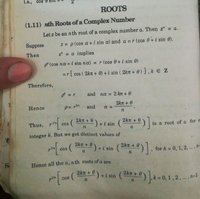Complex Numbers and Trigonometry
- Thread starter adeel17
- Start date
pka
Elite Member
- Joined
- Jan 29, 2005
- Messages
- 11,995
If I understand correctly which is the fifth line: ρn(cos(nα)+isin(nα))=r(cos(θ)+isin(θ))Can anybody let me know how the step is taken at fifth line where is (cos n alpha + i sin n alpha) gone?
That is just a rewrite of the fourth line zn=a where z=cos(α)+isin(α) & a=r(cos(θ)+isin(θ)).
Dr.Peterson
Elite Member
- Joined
- Nov 12, 2017
- Messages
- 16,762
If you mean going from [MATH]r(\cos(\theta) + i \sin(\theta))[/MATH] to [MATH]r[\cos(2k\pi + \theta) + i \sin(2k\pi + \theta)][/MATH], they just replaced [MATH]\theta[/MATH] with [MATH]2k\pi + \theta[/MATH], because adding [MATH]2k\pi[/MATH] to the argument of a sine or cosine does not change its value -- that is, these functions have period [MATH]2\pi[/MATH]. The important idea is that because a complex number can be represented by many angles, there are n nth roots.Can anybody let me know how the step is taken at fifth line where is (cos n alpha + i sin n alpha) gone?
Maths_Mike
New member
- Joined
- Feb 6, 2020
- Messages
- 12
Obviously Cos(na) = Cos(theta) now solve and use general formula for getting all solutions.
They just did that bit first
They just did that bit first

